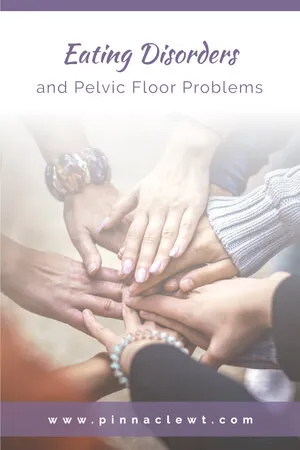I wanted to take a moment to talk about Eating Disorders and their potential impact on the pelvic floor. Over my years of treating girls and women with pelvic floor problems, I found a unique set of clients that came for treatment of incontinence and Pelvic Organ Prolapse (POP) diagnosis’ that had never been pregnant. Prolapse is common after pregnancy and/or child birth as the pelvic organ support ligaments stretch or tear with pregnancy and delivery. But that’s not the whole picture.
There are actually several reasons someone can develop a POP even if they have never been pregnant or delivered a child. When a person cannot manage the pressure system within their core, it can lead to organ dysfunction and/or organ ligament strain and stretching leading to problems with organ support. Common diagnosis associated with poor pressure management include gastric reflux (heartburn), slow transit constipation and POP diagnosis’ like cystocele, rectocele, vaginal prolapse and rectal prolapse to name a few.
So, what are some of those other reasons someone can develop a POP problem then? These include chronic problems such as asthma with frequent sneezing and coughing, chronic constipation with straining to void, engaging in very high impact sports such as trampoline or gymnastics and lifting for a living such as working in a warehouse or a nursing home.
But the group of girls and women I was seeing had something different in common. They were all currently battling or had recovered from an eating disorder.
Eating disorders such as Anorexia, Bulimia and Binge Eating Disorder, affect anywhere from .3% – 6% of the population at any given time. Eating disorders are complex and are beyond the scope of this blog. But if you suffer from any of these; there is help for recovery! You can call or text the National Eating Disorder Association at (800) 931-2237 or go to nationaleatingdisorders.org for more information. There are also local people and agencies that can help closer to home. Know that you are NOT alone.
All eating disorders affect your entire body but those disorders that involve binging and purging can really wreak havoc on your pelvic floor and pelvic organ support. The diaphragm, abdominals and pelvic floor normally work in a synchronous movement pattern for breathing, organ support, voiding and core movement. Of the three core muscle groups, the pelvic floor is often the weakest link. It’s smaller interconnected muscles with openings for the urethra, vagina and rectum make it vulnerable to “giving in” when there is a tug of war so to speak between the muscle groups. When might this tug of war happen in eating disorders? There are actually several, but I want to concentrate on one today. Vomiting.
During vomiting, the abdominals, diaphragm and pelvic floor must increase intra-abdominal pressure enough to help the stomach forcefully expel all stomach contents. To do this, the pelvic floor and abdominals contract up and in to increase pressure up and out. To help this movement, just before vomiting, we take in a deep breath in to decrease the pressure in our chest cavity, close off the trachea (breathing tube) and relax the esophageal sphincter to let the stomach contents out. It’s actually amazingly complicated. The increased intra-abdominal pressure can be so high it can break blood vessels in the eyes and esophagus.
This high, high pressure over time leads to pelvic organ ligament stretching and tearing which results in POP diagnosis’. Instead of your pelvic floor muscles being able to hold against this pressure and help push out the stomach contents, they get tired and can’t hold anymore. This leads to urine and stool leakage when vomiting, and sometimes when not vomiting. It can be any activity that has an increase in intra-abdominal pressure like running, sneezing or laughing. I have seen young women that have actually purged so hard for so long that they have fully pushed one or more of their pelvic organs outside of their bodies.
Sometimes, the pelvic floor does get stronger to withstand the high pressure leading to chronic pelvic floor tension and pain but that is for another time.
I write this not to scare anyone but to inform women. I know there is information out there about how harmful chronic vomiting can be on the body, but I don’t often see a discussion related to the pelvic organs or the pelvic floor. I also want women in recovery to know, that we see you and understand you. And most importantly, that if this is you, we are here to help you!
There are solutions to help with POP regardless of what caused it. Reach out and schedule your free consult to discuss your unique concerns.



